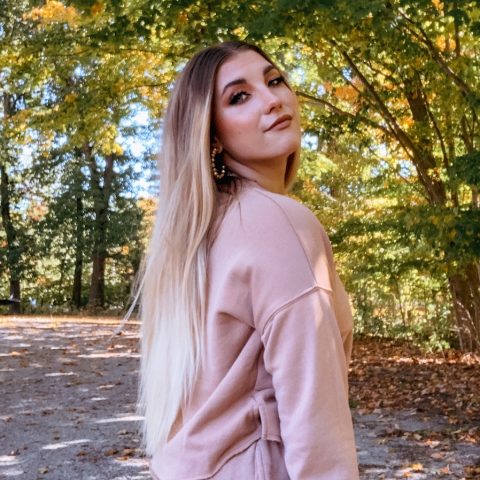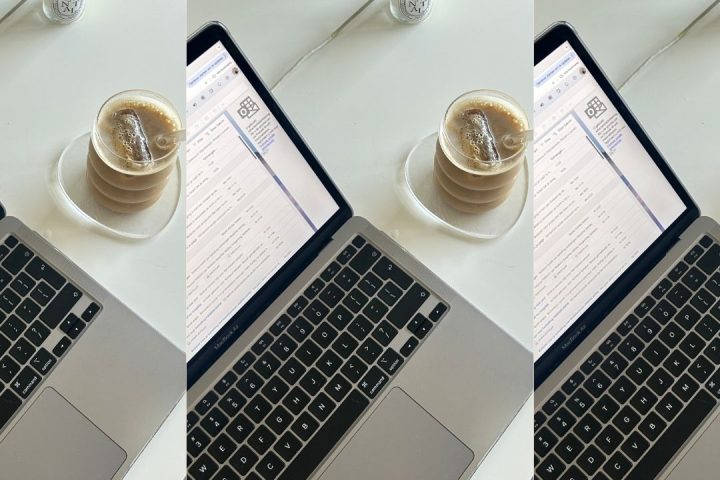I didn’t realize it until I was in college, but I’ve been a highly anxious person my entire life. From hiding behind my mom’s leg at social gatherings, to avoiding networking at all costs as an adult, I’ve been a chronically anxious girlie since day one. After coming to the realization about ten years ago, I’ve taken measures to keep my anxiety at bay—including frequent exercise and medication. But if there’s one thing about my anxiety, it’s that it will always find a way to creep up on me and send me spiraling. So when I found out about the 5-5-5 rule on TikTok, I was intrigued (and beyond ready) to give it a try—and it didn’t disappoint. Here’s everything you need to know about combating anxiety with the 5-5-5 Rule.
What is the 5-5-5 Rule?
I first stumbled across the 5-5-5 rule when I saw a TikTok video by user @mjkimbrough. In the short clip, he’s sitting on the couch, visibly stressing. Over the video, he wrote, “pov: you feel anxious because you can’t stop overthinking things.” Which, like, so real, my guy. I was locked in at that point, ready to see where he was going with it, when “the 5-5-5 rule” popped up on the screen. I’m a sucker for all of these trendy number sequence rules (hello 10-10-10 rule and 3 by 3 by 12 rule), so obviously I needed to know more. In the caption, Kimbrough wrote, “Most people overthink because [they] apply too much importance to small things. Overthinking causes you to get stuck, worry and lose focus on the things that actually matter.”
He continues to explain that, essentially, the method asks you to pose three questions when things feel overwhelming: Will this really matter in five minutes, five days, or five years? Officially intrigued, I dug a little further into the topic and found another TikTok video posted by @theanxiouspsych expanding on the mental wellness practice. She explained, “The 5-5-5 rule is a rule that helps you to assess the size of a problem and then helps you to understand how big your reaction really should be to that problem.” The Anxious Psych added that you could even think about the issue in terms of five weeks and five months to bring more perspective to your anxiety. “It helps to put things in context when your worries are feeling really out of control and kind of bigger than you can handle in that minute,” she explained.
Benefits of The 5-5-5 Rule
It contextualizes emotions
Anxious emotions quickly run rampant and can be difficult to rein in—trust me, I know. But with the 5-5-5 rule, I can put my worries into perspective and assess whether my reaction is truly justified. “I find this strategy so helpful because it really helps me contextualize the worries that I’m experiencing and understand if my anxiety is rational in that moment or if it’s too big,” shared TikTok creator @theanxiouspsych.
It diffuses immediate stress
By taking a moment to contextualize an anxious spiral, I can almost always diffuse some of my stress within a few minutes. “What this strategy does is it helps us scale down our reactions to what the size of the problem is,” @theanxiouspsych explained. I’ll take any tip or trick that keeps me from spiraling for hours on end!
It breaks cycles of overthinking
When I got into the habit of regularly using the 5-5-5 rule, I was able to work toward effectively managing my anxiety. I’m a chronic overthinker, HBIC of the Anxious Express if we’re being honest, and I’ve found the 5-5-5 rule really valuable for quickly stopping my spiraling thoughts by pausing to ask three simple, rational questions.
Practicing The 5-5-5 Rule IRL
Adding the 5-5-5 rule to your life is really easy (as easy as falling into an anxiety spiral)! It just takes a concerted effort to consciously think about the rule during an anxious moment. The first time I found myself overthinking after I learned about the 5-5-5 rule, I took a few deep breaths to calm myself, then I asked myself if what I was worried about would matter in five minutes. While I could admit that it wouldn’t matter to literally anyone but me in five minutes, I also recognized that in five minutes, it would definitely still be bothering me.
Moving on to the five-day metric, I was able to get a little more perspective. By the time five days would pass, I knew I’d be able to address and move past the issue, and thus, dissipate the bulk of my anxiety. While I thought I might still look back on the situation and feel the Ghost of Anxiety Past, I didn’t think I’d still be feeling the same depth of anxiety at that point. Feeling less anxious already, I faced the big question: Would this matter in five years? The answer was an immediate no. In five years, I probably wouldn’t even remember that I was ever worried about the issue in the first place. Within five minutes, I was calmer and clearer-headed. Even though I was still feeling a few tendrils of anxiety, I was able to reaffirm that the situation wasn’t as big a deal as I was making it out to be in my mind.
So the next time you’re feeling anxious, take a few centering breaths, then ask yourself those three questions: Will this matter in five minutes? Will it matter in five days? And what about in five years? When you take the time to work through each scenario, you just might realize that your inner anxiety monster was making things seem scarier than they really are.

Alyssa Davis, Contributing Writer
Alyssa Davis is a freelance writer specializing in home, lifestyle, beauty, and entertainment content. She studied English at Indiana University and has since produced articles for publications including SheKnows, Architectural Digest, and Well+Good, to name a few.
The post I’m Chronically Anxious, but the 5-5-5 Rule Keeps Me From Spiraling appeared first on The Everygirl.
Source: Cosmo Politian











